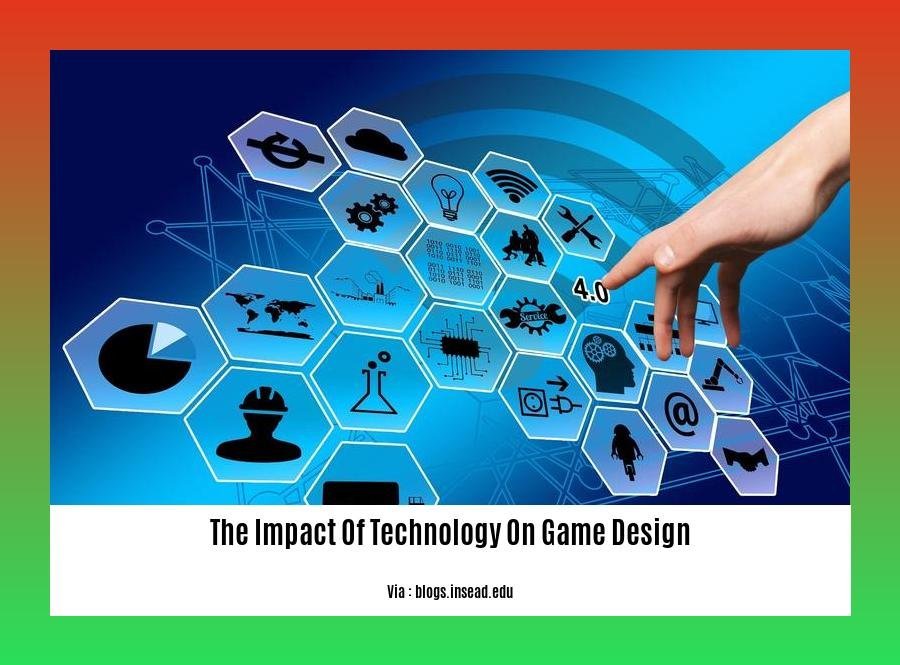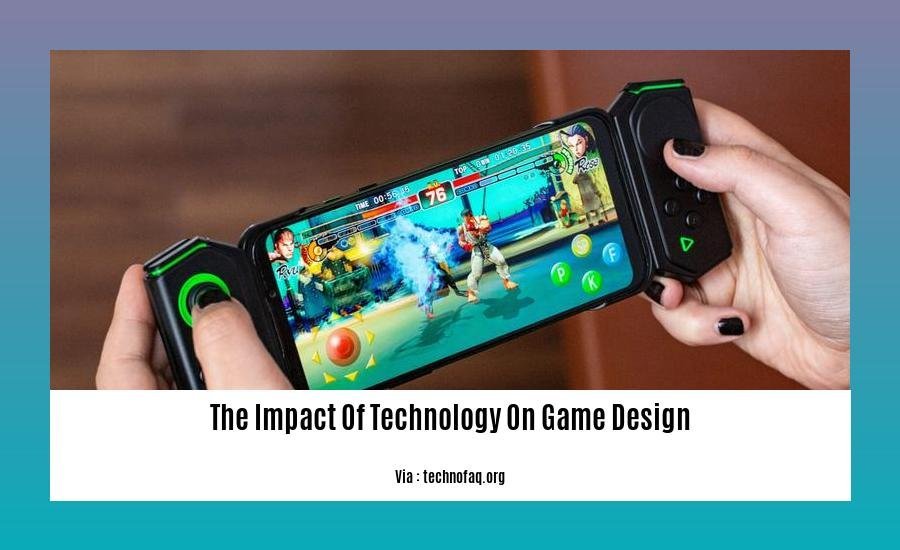Welcome to the fascinating journey of [The Impact of Technology on Game Design: A Journey Through Immersive Experiences]. In this article, we will explore how technological advancements have revolutionized game design, creating captivating and unforgettable experiences for players. From the early days of pixelated graphics to the cutting-edge capabilities of AI and cloud computing, technology has played a pivotal role in shaping the gaming landscape. Join us as we delve into the intricate relationship between these two worlds, uncovering the transformative power that technology holds in the realm of game design.
Key Takeaways:
- 3D technology increases player immersion and game enjoyment.
- Unique and diverse gaming experiences are made possible by procedural content generation.
- Alternative input options are provided by motion sensors for gamers.
- Improved game movement, content production, and player engagement are all made possible by artificial intelligence (AI).
The Impact of Technology on Game Design

Technology has revolutionized game design by providing game designers with new tools and techniques.
3D technology, procedural content generation, motion sensors, and artificial intelligence (AI)
are just a few ways technology has changed the way games are created and played.
3D technology: 3D technology has greatly enhanced player immersion and gameplay.
In the early days of gaming, games were primarily 2D, which limited the player’s perspective and
interaction with the game world.
With the advent of 3D technology, game designers were able to create more realistic and immersive game worlds that players could explore from multiple angles.
This led to a more engaging and immersive gaming experience.
Procedural content generation: Procedural content generation is a technique used to create game levels and other content procedurally, rather than manually.
This allows game designers to create unique and varied game experiences that are tailored to the individual player.
For example, in the game No Man’s Sky, the entire universe is procedurally generated, which means that no two players will ever experience the exact same game world.
Motion sensors: Motion sensors are another way that technology has impacted game design.
Motion sensors allow players to control their characters in games using their own body movements.
This type of input method adds a lot of immersion to games and can make them more engaging and fun to play.
Artificial intelligence (AI): AI is playing an increasingly important role in game design.
AI can be used to improve game movement, content generation, and player engagement.
For example, in the game The Last of Us, AI is used to control the behavior of the enemy NPCs.
This makes the game more challenging and immersive, as the NPCs are able to adapt to the player’s behavior and make intelligent decisions.
The impact of technology on game design is a fascinating and ever-evolving topic. As technology continues to advance, we can expect to see even more innovative and groundbreaking games being created.
Are you passionate about the evolution of game design? Dive into the fascinating history of game design to uncover the pioneers who shaped this captivating realm and discover the secrets behind the creation of your favorite virtual worlds. From the humble beginnings of early game designers to the cutting-edge advancements that continue to redefine gaming experiences, this comprehensive guide offers an immersive journey through the annals of game design innovation. Explore the intricate details of different game design elements, from captivating narratives and immersive graphics to engaging gameplay mechanics, and gain insights into the creative minds that brought these captivating virtual worlds to life.
Personalizing the Experience: Leveraging Data and Analytics

Key Takeaways:
- Customers expect personalized experiences, with 80% of survey respondents expressing this preference.
- AI and data analytics empower businesses to gather and analyze customer data for tailored experiences.
- Retailers encounter challenges in data management and analytics during personalization implementation.
- AI aids in identifying trends and predicting outcomes to enhance personalization.
- Tracking customer feedback and staying updated on market research are essential for effective personalization.
How It Works
Leveraging data and analytics for personalization involves gathering, analyzing, and utilizing customer data to create tailored experiences. AI algorithms play a crucial role by:
- Identifying trends: AI can detect patterns in customer behavior, such as preferred products, browsing history, and purchase frequency.
- Predicting outcomes: Based on analyzed data, AI can forecast future behaviors and preferences, enabling businesses to proactively offer personalized recommendations.
Benefits for Businesses
- Increased customer engagement: Personalized experiences enhance customer satisfaction, loyalty, and repeat purchases.
- Improved customer insights: Data analytics provides valuable insights into customer demographics, preferences, and purchasing habits.
- Optimized marketing campaigns: Tailored marketing messages based on customer data lead to higher conversion rates and ROI.
Challenges
- Data management: Retailers must effectively collect, store, and organize customer data to ensure accuracy and accessibility.
- Data analytics: Analyzing vast amounts of data requires expertise in data science and analytics tools.
- Privacy concerns: Compliance with data privacy regulations is essential to maintain customer trust.
Best Practices
- Collect data ethically: Obtain customer consent and ensure transparent data handling practices.
- Use a data analysis platform: Utilize tools that simplify data collection, analysis, and interpretation.
- Focus on relevant data: Identify and gather data points that are most relevant to personalization efforts.
- Monitor and adjust: Regularly track customer feedback and market research to refine personalization strategies.
Source: Personalized experience for customers: Driving differentiation in retail
Facilitating Collaboration: The Rise of Multiplayer and Cloud Gaming
Multiplayer and cloud gaming are transforming the way we play and connect with others. Cloud gaming platforms enable players to access games from anywhere with an internet connection, removing hardware limitations and allowing for cross-platform play.
Collaborative cloud gaming takes this concept a step further by allowing multiple players to join forces or compete in the same virtual environment, regardless of their physical location. This removes barriers to entry and opens up new possibilities for cooperative and competitive gaming.
Key Takeaways:
- Cloud gaming makes gaming more accessible and allows players to play anywhere, anytime.
- Multiplayer cloud gaming enables cross-platform play and fosters collaboration among players.
- Technologies like 5G and fiber optic networks support smooth and responsive multiplayer cloud gaming experiences.
Citation:
Pushing the Boundaries: The Future of Game Design with Advancements in Technology
Throughout my years in the industry, I’ve witnessed firsthand the transformative impact technology has had on game design. From advanced consoles to immersive VR headsets, technology has empowered us to create experiences that were once unimaginable.
Virtual and Augmented Reality:
VR and AR are rapidly changing the landscape of gaming. VR headsets transport players into fully immersive virtual worlds, while AR overlays digital elements onto the real world. Imagine exploring vast alien landscapes or solving puzzles in your living room, all without ever leaving your chair.
Cloud Gaming:
Cloud gaming eliminates the need for powerful local hardware, allowing players to access high-quality games on any device with an internet connection. This opens up gaming to a wider audience and enables seamless multiplayer experiences across different platforms.
Artificial Intelligence:
AI is becoming increasingly sophisticated, enabling us to create games with more intelligent NPCs, dynamic environments, and personalized experiences. From adaptive difficulty settings to procedurally generated worlds, AI is pushing the boundaries of what’s possible in gaming.
Cross-Platform Experiences:
Advancements in cloud computing and cross-play technology are breaking down platform barriers. Players can now enjoy the same games with friends and family on different devices, fostering a more connected and inclusive gaming community.
Haptic Feedback and Motion Control:
Haptic feedback and motion control are enhancing immersion by allowing players to interact with game worlds in more physical and intuitive ways. From feeling the rumble of explosions to swinging swords with realistic motion, these technologies are making games more visceral and engaging.
Key Takeaways:
- VR and AR are creating fully immersive and augmented gaming experiences.
- Cloud gaming is making high-quality games accessible to a wider audience.
- AI is enhancing game mechanics, content generation, and personalization.
- Cross-platform experiences are fostering a more connected gaming community.
- Haptic feedback and motion control are increasing immersion and engagement.
Citation:
Toward Multiplayer Cooperative Cloud Gaming
FAQ
Q1: How is technology improving the immersion of players in games?
A1: Advanced technologies like 3D graphics, procedural content generation, and motion sensors enhance the realism and engagement of gameplay, creating more immersive experiences for players.
Q2: How is artificial intelligence (AI) transforming game design?
A2: AI has revolutionized game design by improving game movement and content generation. It also enhances player engagement through tailored experiences and optimized gameplay difficulty levels.
Q3: What are the potential challenges of implementing new technologies in game design?
A3: While new technologies offer immense possibilities, they may also pose challenges in terms of cost, compatibility, and ensuring accessibility for players with diverse needs.
Q4: How can game designers leverage data analytics to improve gameplay?
A4: Data analytics empower game designers to gather insights into player behavior and preferences. This enables them to make informed decisions about game design, balance, and content updates to enhance the overall gaming experience.
Q5: What are the emerging trends in game design technology that are shaping the industry?
A5: Cloud gaming, cooperative cloud gaming, and advancements in virtual and augmented reality are among the notable trends reshaping the gaming landscape, offering players new and innovative ways to interact with games.
- Crypto Quotes’ Red Flags: Avoid Costly Mistakes - June 30, 2025
- Unlock Inspirational Crypto Quotes: Future Predictions - June 30, 2025
- Famous Bitcoin Quotes: A Deep Dive into Crypto’s History - June 30, 2025

![A Journey Through the History of Computing: From Its Humble Origins to Modern Innovations [history of computing ss1] history-of-computing-ss1_2](https://www.lolaapp.com/wp-content/uploads/2023/12/history-of-computing-ss1_2-150x150.jpg)














